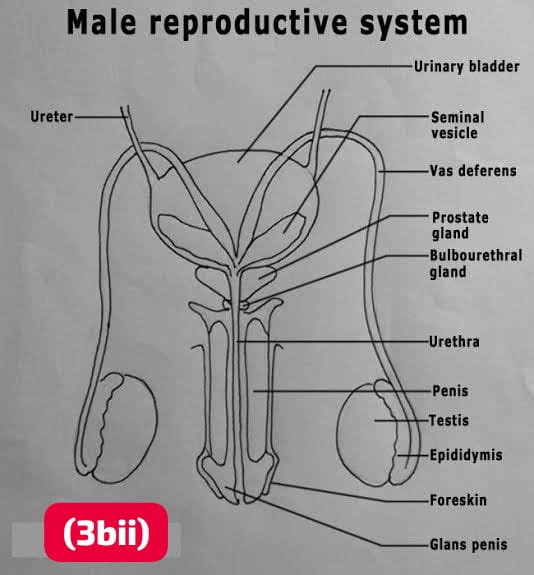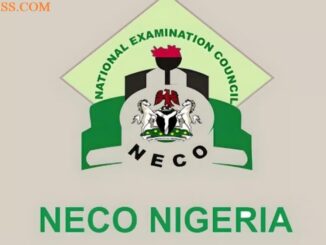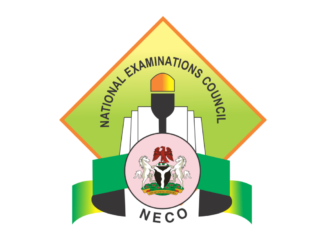Welcome to “Naijaclass Academy” For Neco 2024 Biology Objective & Essay Answer (June/July Exam)
Tuesday, 2nd July 2024
Biology (Objective & Essay) 2:00pm – 4:30pm
=======================

BIOLOGY OBJ!
01-10: EEDDDEEAAE
11-20: DABBCAEEBD
21-30: ACECCDADED
31-40: DDBEBAEDBA
41-50: BACABABDDE
51-60: ECDCDCCADA
Use this obj, some corrections is being made
=============================================
BIOLOGY ESSAY ANSWERS
(1ai)
(i) Producers (plants, algae)
(ii) Consumers (animals, insects)
(iii) Decomposers (bacteria, fungi)
(1aii)
(i) Mandibles (jaws)
(ii) Maxillae (maxilla)
(iii) Labium (lower lip)
(1bi)
(i) Blood enters the glomerulus under high pressure, causing water, salts, glucose, and waste products to filter out of the blood into Bowman’s capsule, forming a filtrate.
(ii) As the filtrate moves through the proximal convoluted tubule, loop of Henle, and distal convoluted tubule, essential substances like glucose, certain ions, and water are reabsorbed back into the blood.
(iii) Additional waste products and excess ions are secreted from the blood into the tubular fluid. The final product, urine, moves from the collecting ducts into the renal pelvis, down the ureters, and into the bladder for storage before excretion.
(1bii)
(i) Malleus (hammer)
(ii) Incus (anvil)
(1biii)
[TABULATE]
=PHOTOSYNTHESIS=
(i) Converts light energy into chemical energy stored in glucose.
(ii) Produces oxygen as a by-product
=RESPIRATION=
(i) Converts chemical energy in glucose into usable energy (ATP).
(ii) Produces carbon dioxide as a by-product
=============================================
(2ai)
(i) Wings (modified forelimbs)
(ii) Hollow bones (reduced weight)
(iii) Lightweight skeleton (reduced weight)
(iv) Powerful muscles (for wing movement)
(2aii)
-Pollen from anther (male part) is transferred to stigma (female part)
-Pollination occurs through agents like bees, butterflies, wind, or water
-Fertilization occurs when pollen germinates and sperm reaches the egg
-Seed formation and fruit development follow successful pollination
(2bi)
(i) Long, sticky tongue (for catching prey)
(ii) Specialized teeth (for holding onto prey)
(iii) Webbed feet (for movement and hunting)
(2bii)
[TABULATE]
=ARTERIES=
(i) Carry blood away from the heart
(ii) No valves (except for the pulmonary artery and aorta)
(iii) Narrower lumen compared to veins
(iv) Thick, muscular, and elastic walls
=VEINS=
(i) Carry blood towards the heart
(ii) Valves present to prevent backflow of blood
(iii) Wider lumen compared to arteries
(iv) Thinner, less muscular, and less elastic walls
=============================================
(3ai)
(i) Phototropism (growth towards light)
(ii) Geotropism (growth towards gravity)
(iii) Hydrotropism (growth towards water)
(iv) Thigmotropism (growth towards touch)
(3aii)
(i) Loss of fertile land and decreased agricultural productivity
(ii) Increased sedimentation in water bodies, harming aquatic ecosystems
(3bi)
Grass=>Grasshopper=>Lizard=>Hawk
(3bii)
Diagram of the male reproductive system:

(3biii)
(i) Oxygen (O?)
(ii) Glucose (C?H??O?)
=============================================
(4ai)
(i) Humerus
(ii) Radius
(iii) Ulna
(4bi)
(i) Insulin (regulates blood sugar levels)
(ii) Adrenaline (responds to stress)
(iii) Growth Hormone (regulates growth and development)
(4bii)
-Amoeba: Contractile vacuole
-Hydra: Diffusion through body surface
-Earthworm: Nephridia
-Grasshopper: Malpighian tubules
(4biii)
(1) Mitochondria: Generates energy for the cell through cellular respiration
(2) Lysosomes: Contains digestive enzymes to break down and recycle cellular waste and foreign substances
=============================================
(5a)
Diagram

(5bi)
[TABULATE]
=MONOCOT PLANTS=
(i) Leaf Venation; Parallel venation
(ii) Number of Flower Parts; Usually in multiples of three
=MONOCOT PLANTS=
(i) Leaf Venation; Reticulate (net-like) venation
(ii) Number of Flower Parts; Usually in multiples of four or five
(5bii)
(i) Fossil Record: Shows changes in species over time, with transitional forms demonstrating common ancestry.
(ii) Comparative Anatomy: Homologous structures (e.g., limb bones in vertebrates) indicate common ancestry.
(iii) Molecular Biology: DNA and protein sequence similarities among different species suggest evolutionary relationships.
(iv) Biogeography: Distribution of species across different geographical areas supports patterns of evolution and migration.
(5biii)
(i) Hinge Joint
(ii) Ball-and-Socket Joint
(iii) Pivot Joint
COMPLETED






cant we get it for free
091629(SPAM)
Message me on Whatsapp to get it
Brogrammer, WE BLOCK SPAM ON OUR WEBSITE
Pls i will send the card but i dont have money today
But I don’t have money now
Inbox me lemme give you for fre
Send me pin
Hi
Just questions only
Question and answer
Please
Thanks sir
Can I send you my answers in not fake
nothing is free even in Freetown
Really
Can I get it for free
Anyone wey get d biology theory answers share with us even tho na quarter of it abeg
I have it
I need it
I need it
I have the questions
Can’t you write yourself?
You number
Biology question and answer of tomorrow afternoon
Yes
Pls send it to me
Please can you send to me biology essay and objective 2024
I need it
please i did practical biology and questions and answers
what tym
Yeah
I want the answer
the
Yes
Yes
Abel we need am drop for us tomorrow1
SHARE WITH US THE BIOLOGY ESSAY & OBJECTIVES
We will share with you when you pay for it
Please can I get your WhatsApp number
Hello
Please can we get it for free this evening
can i get it this evening
Answers are available
help me with the rest of the answers of all subject please
Even if na only question we go run the answer ourselves
If na only question we go run the answer ourselves
Gk boss, please chat with us on Whatsapp
Pls send it
Who can share with me ooo please
uiig
Biology questions and answers for tomorrow
Pls i need biology
Can’t we get biology only for free
Abi pls ooo we beg in the name of God
You need to make payment
How are my going to know when the answer are out
If u ve gotten drop small for us oo abeg
pls help us
pls help us
Message me
wat of us wey no get android phone
Use Online pin Option which is very cheap
Ma pls help me i dont have money i have not eat since yestaday night pls help
Go buy na
Pls help us now
I need to greet my friends in all
I have the answer in full (theory)
interesting…
please send
I have it just message me 0802(SPAM)332
Message me
I need it
Interested
I have the answers
I need too
Really
Kai nigeria